Menu
Yes, some scientific work can be affected by the impacts of climate change – especially scientific research that looks at the environment and plants and animals.
Lots of plants and animals around the world are moving habitats because the climate is changing where they have typically lived before. This phenomenon is known as ‘species on the move’.
In Australia, the water in Eastern Australian Current (known as the ‘EAC’ in Finding Nemo 😊) is warming because of climate change and as a result, the current is travelling further down the east coast of Australia than it used to – bringing marine species with it. For example, the Gloomy Octopus is not typically found in Tassie but has been spotted as far south as Falmouth on the east coast. Some Tiger Sharks have also been seen as far south as St Helens! Scientists who study these ‘species on the move’ now need to change their work to try to understand where species are moving, how fast they are moving, and what these moves might mean for the ecosystems that already exist in these places.
You might like to check out Redmap which is a website where people from all over Australia are invited to log any marine species they see that are new or atypical to coastal areas around the country. Scientists verify these sightings of ‘species on the move’ and the information is stored in a national database so scientists and the community can document how marine life is responding and moving because of climate change.
Indeed, why don't we?!
Burning fossil fuels like coal to provide electricity will soon be a thing of the past. Because we now know that they create harmful carbon-dioxide emission, all around the world, coal-fired power stations are being shut down, and new renewable energy industries are being created in their place.
But if you look at Australia, most states are still mostly powered by fossil fuels. Tasmania is a stand-out here - we have almost 100% renewable energy already thanks to our hydropower system. But in Victoria and New South Wales, we still have coal-fired power stations, and governments do not want them to close any time soon. Why not? There are two main reasons. The first is that if we shut them down now, we wouldn't have enough renewable energy sources to provide the electricity we need in their place. The second is that many people have jobs in the coal mining and coal power industries, and if we closed them down tomorrow, whole towns could be out of work.
What we need to do in Australia, and other countries that still burn coal, is to plan a transition from coal to renewables over the next few years. This will help to both replace coal with things like wind, solar and hydropower, and make sure that there are new jobs for people who have historically worked in the coal industry. Doing this sooner rather than later will be better for the planet and for Australia's economy.

Absolutely! And many countries already are. For example, Costa Rica's energy is nearly entirely from renewable sources. Over 99% of the energy in Costa Rica was generated from renewable energy. The majority of this energy, 67.5 percent, comes from hydropower. Additionally, wind power generates 17 percent, geothermal sources make up 13.5 percent and biomass and solar panels comprise 0.84 percent.
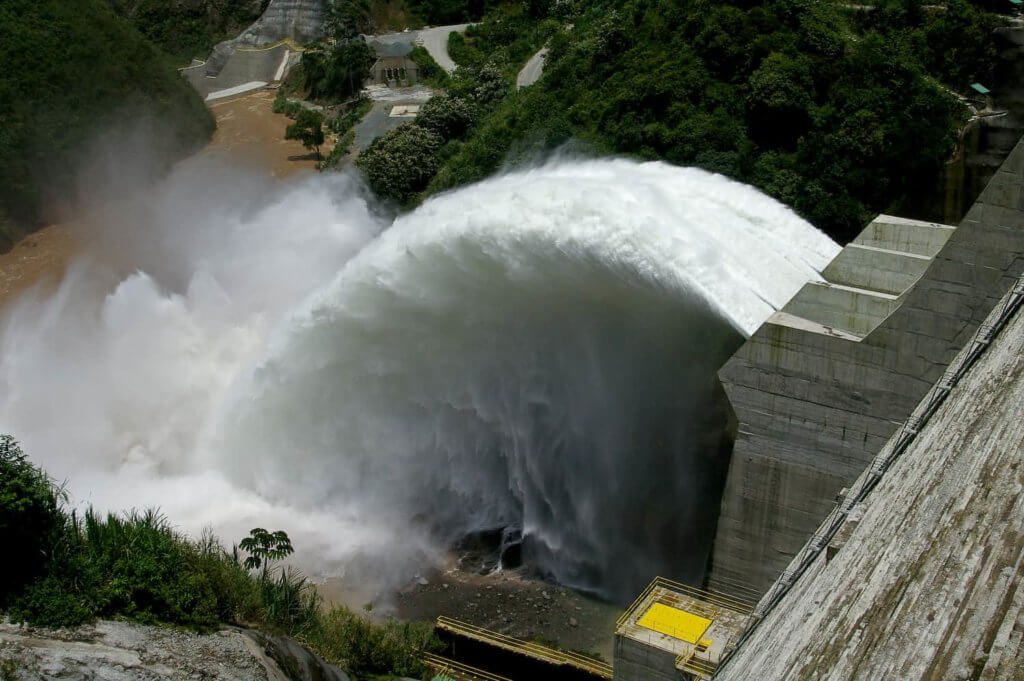
Costa Rica set the record in 2017 for most consecutive days with renewable energy, with 300 consecutive days on renewable energy alone. In 2018, Costa Rica’s new president, Carlos Alvarado, announced at his inauguration that he plans to ban all fossil fuels and become the world’s first decarbonized country.
Another interesting development in renewable energy has been the increase in renewable microgrids. Microgrids are local energy grids with control capabilities, that can work independently to produce and supply power to small communities.
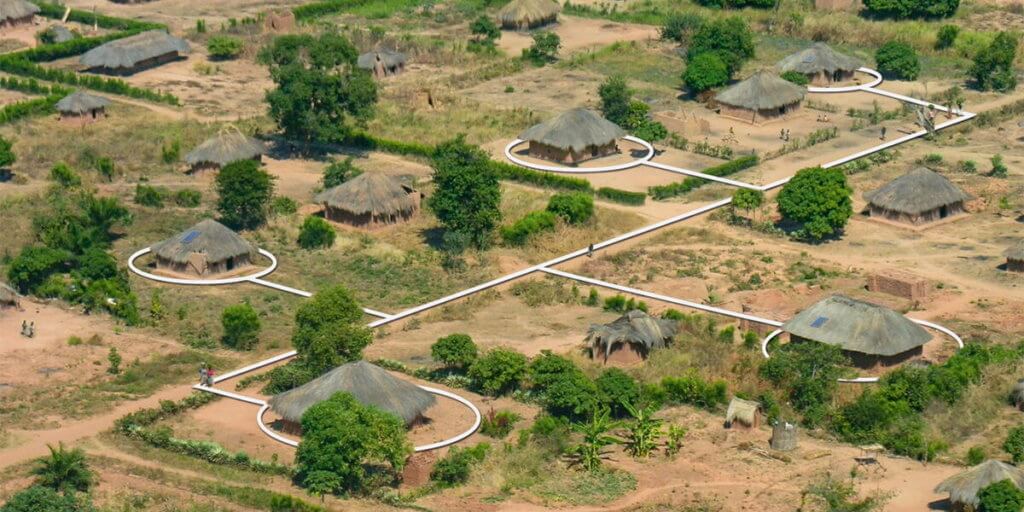
Solar minigrids in particular are being used in rural communities to replace diesel generators with renewable energy supplies. In the case of solar, a series of solar panels are all linked together to store the power in a shared battery and control room!
Other Sources:
https://ieeexplore.ieee.org/document/7991293
Great question! And the answer is yes, climate change can cause sickness in lots of ways. Illness from extreme heat, bushfires and bushfire smoke, and the spread of diseases like malaria are all linked to climate change. One of the biggest risks to athletes is having to play or train in extreme heat. As you probably know, climate change is making extreme heat events (or heatwaves) longer and more common. So it’s becoming more likely that most athletes will need to play or train in these sorts of conditions, especially sports that are normally played outside and over summer (like athletics, tennis or cricket).
Exercising when its really hot can potentially make you very sick. Your body needs to stay within a certain temperature range (36.1°C-37.2°C) to operate effectively, and we have lots of mechanisms to make that happen (like sweating, for example). If the conditions we are training or playing in mean our body is unable to stay within that range, then we can get a heat-related illness. This can be mild, like a headache or feeling dizzy, and if we cool down, then our body can keep doing what it was doing before. However, if we can’t cool down adequately, then it becomes a problem. This is called heat stroke and it’s a very serious and life-threatening condition. If you want to see what this looks like, watch this clip of Scottish marathon runner Callum Hawkins competing in the 2018 Commonwealth Games on the Gold Coast. It’s a reminder that when we are training or competing in a hotter environment that usual, we need to take time for our body to get used to the new conditions. This is called acclimatising.

Another impact of climate change is the increased risk of bushfires. These can generate a lot of smoke, and the smoke can travel a long way. We saw that in the Black Summer fires in 2019-20, when smoke from those fires travelled right around the world (watch this amazing clip from NASA!). If athletes are training or playing when the smoke levels are high, this can also make them sick. Its not good for your body to breathe in lots of smoke, especially when you are breathing hard, like when you are playing sport.
That’s a big question! I’ll concentrate on air pollution, as this is linked to climate change. Air pollution is made up of lots of chemicals, some of which are harmful to us. The amount of these chemicals in the air (called the concentration) is the most important thing, as we are more concerned when there are higher levels of the chemicals that make us sick. The ones that are most common and harmful to people are particulate matter, ozone, nitrogen dioxide, sulphur dioxide and carbon monoxide. These chemicals come from many places, including cars, factories, bushfires and even wood heaters.
In Tasmania, we have some of the cleanest air in the world, because we don’t have huge cities with lots of cars and factories. Lucky us! But we still get air pollution in the form of smoke from wood heaters and from bushfires. Although smoke is made up of many chemicals, the main we know about and can make you sick, is called particulate matter. These are very tiny particles, only about 3% of the diameter of a human hair. When there are many of these particles in the air, you can smell smoke and the air will be hazy. These particles often irritate your eyes and nose and you might get a headache. Some people can become very sick if they breathe in these particles, especially people with asthma. The more of these types of particles you breathe, the more chances you have of getting sick.
You would have heard about carbon dioxide as one of the main chemicals that contribute to climate change. Some people say that carbon dioxide isn’t really an air pollutant, as we need a certain level to maintain life on earth (in fact, our bodies make carbon dioxide as part of our normal function, so we always have some in our system). But too much carbon dioxide in the atmosphere is really the problem with climate change, as it keeps the earth too warm. So you could call it a pollutant in large concentrations. This is why it’s important to keep track of this chemical in the atmosphere.
Stopping, or reducing climate change, known as mitigation, is something that is really important so I’m very glad you’ve asked how to do this.
Reducing climate change will involve lowering the level of greenhouse gases in the atmosphere. This means reducing the emission of heat-trapping greenhouse gases. This is done by reducing the use of fossil fuels and moving to renewable energy sources, like wind, solar and ocean wave energy instead. The effectiveness of these energy sources is improving all the time and around the world (especially in Australia) they are becoming a major source of energy already. Increasing efficiency and finding ways of reducing energy use and waste is also very important. Around the world businesses and governments are making commitments to reduce the use of fossil fuels and to transform manufacturing, food production and transport (e.g. trucks, cars, trains and shipping) to electricity or other fuels (like hydrogen).
Another way to help mitigate climate change is to support processes that actively remove carbon out of the atmosphere. Healthy oceans, forests and soil are great carbon stores. This means restoring and protecting these environments and supporting sustainable practices will help. Growing trees is a great way of helping remove carbon from the atmosphere. This effect is so large that the natural regrowth of Tasmania’s forests means that the state is currently a carbon sink – meaning more carbon is removed from the atmosphere than is emitted. This means as a state Tasmania is doing better than the net zero emissions target governments around the world are talking about.
Rather than just letting the trees do all the heavily lifting though we can help Australia and the world by reducing our individual emissions. On a personal level that means turning lights and appliances off when you’re not using them; putting on a jumper rather than turning the heating up to full; and walking, cycling, or using public transport if we can. Also finding out about what you eat and changing to options that contribute less to climate change can also help. Agriculture is a major producer of greenhouse gases so look for low carbon meals, such as sustainable seafood and local seasonal foods, and try having at least a couple of red meat free days a week.
In addition to reducing energy use we can also consume less (e.g. use clothes for longer rather than chasing the latest fashion look), increase recycling and appropriately dispose of organic waste (e.g. food scraps). Methane is a powerful greenhouse gas, over twenty years it is about 80 times more potent at warming than carbon dioxide. When food and garden waste is buried with general garbage the microbes and chemical processes that break the waste down cannot easily access oxygen and so they produce a lot of methane (known as anaerobic breakdown). However, if you put the organic waste into a compost bin (at home or one provided by the council) the microbes can access oxygen and so they use a process that produces much less methane (known as aerobic breakdown). The nutrient rich compost that results also means more plants can be grown (absorbing carbon) and less energy is needed to make artificial fertiliser. A win-win-win.
The biggest thing you can do to help climate change is to stay informed, to help share useful information and to think about your actions – each little bit really does help. Around the world innovations and action by young people is helping accelerate action to reduce climate change.
For starters, you might like to find out how Tasmania’s tree growth is helping our carbon budget. NASA also has a great page on climate change, which mentions some solutions. The United Nations also has some high-level information on different activities around the world.
You might also like to play with the simple climate model at en-Roads, explore options for reducing climate change
Polling about climate change worldwide shows that most people understand climate change and are concerned about it. The largest ever survey to understand how people think about climate change and climate action shows that an average of 64% of people worldwide think that climate change is an emergency that needs rapid action. Despite this, there are still people who deny that climate change exists or that it needs to be urgently responded to.
There is some research that suggests that trying to win over “climate sceptics” with arguments about the irrefutable findings of climate science doesn’t really help convince them. It may even push them further into denial of climate change. If we are having a conversation about climate change with someone who doesn’t “believe” in climate change, we should try to be aware of what they value – and then speak about those things in relation to climate change.
This question also asks about some of the biggest ‘denier’ arguments, so let’s address those:
Climate change isn’t anthropogenic (caused by humans)
The argument here is that the climate has always changed and that current climate change is just a natural phenomenon. Decades of painstaking climate science show this is not the case. Putting more CO2 in the atmosphere causes the planet to heat. Atmospheric CO2 concentrations have fluctuated over geological time, but we know that over the past million years they have never been as high as they are today and that the current increase is definitely caused by human activity.
Climate scientists don’t agree that climate change is happening
This is not true. Research shows that 99% of publishing scientists who work in the area of climate change agree that climate change is happening now and that it is anthropogenic.
We can’t do anything about climate change (it’s too late)
It’s true that we have left it very late to take meaningful action on climate change – but it is not too late to make transformational change that will reduce the worst impacts of climate change. We can’t return to the climate of the past, but we can work towards the best possible future under climate change. We have no time to waste.
It’s been cold lately – that’s proof that climate change isn’t happening
Incorrect. This claim confuses weather and climate. Weather always fluctuates day to day. Climate is the long term average of weather. And that long term average is changing: the planet is definitely heating up. We know it has heated 1.1°C since pre0industrial times.
If you’d like to do some more reading and thinking about how to talk with climate change deniers, you can start with this excellent article by BBC.
Could the Earth ever enter another ice age? The short answer is quite probably, but maybe not for a very long time. However, nothing is certain, especially with the current human-induced changes now occurring. To explain why the answer is probably, we can look at what we know about past climate.
The Earth’s climate has varied over millions of years (see Figure 1). You can see that it was very warm around 56 millions years ago, and very cold around 25,000 years ago. The temperature has generally increased since about 20,000 years ago. But you can also see that there are a lot of ‘little’ ups and downs’. If you look at Figure 2, this shows variations over the last 800,000 years. The line in the middle is temperature. You can see that there are semi-regular periods of colder temperatures (glacial periods, or what some people call ice ages) that last for tens of thousands of years. The warmer (inter-glacials) and colder periods (glacials) can be related to a number of factors that affect Earth’s climate from ‘outside’ the Earth. We call these external forcings.
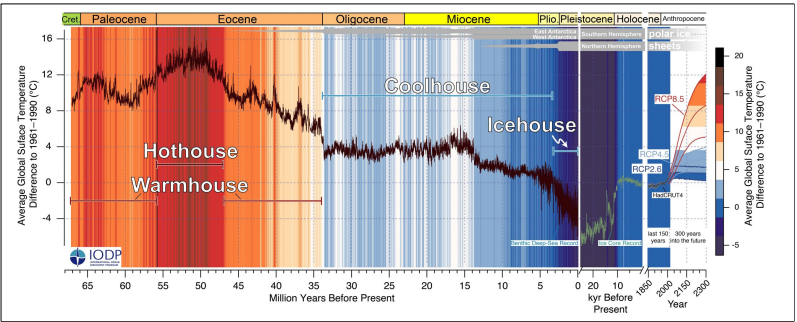
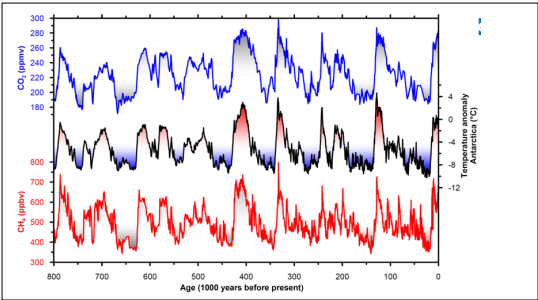
One of the important external forcings of glacial and interglacial periods is related to how earth travels around the sun. About 100 years ago, a smart guy from Serbia called Milutin Milankovic realised that there were three important ways the Earth’s orbit around the sun changed over long time periods. We can call these, stretch, wobble and roll (see Figure 3). These have periods (or cycles) of thousands of years. If you look at Figure 2 again, you can see that warm temperature periods occur around once every 100,000 years (give or take). This is very similar to the period of how Earth’s journey around the sun changes over time (stretch). So, around every 100,000 years, our orbit becomes more ‘circular’ or ‘less elliptical’, so we are closer to the sun. When our orbit becomes more elliptical, we are further away from the sun for much of the time, and our climate is cooler. The other two cycles are also important, but less relevant to your question. They will have important impacts on seasonal differences in the hemispheres and day lengths from the equator to the poles. In Figure 4, there’s a plot of the cycles over time, and down the bottom is a plot of stages of glacial and interglacial periods.
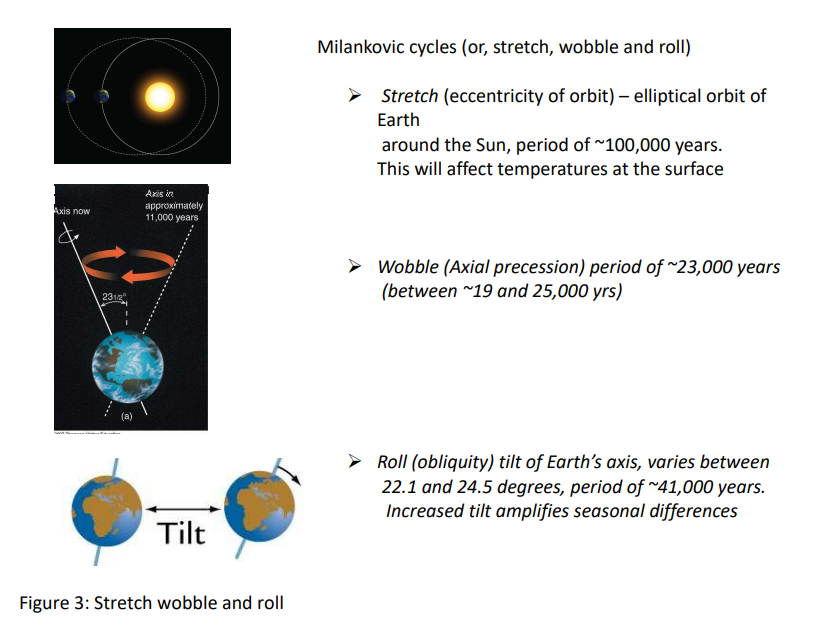
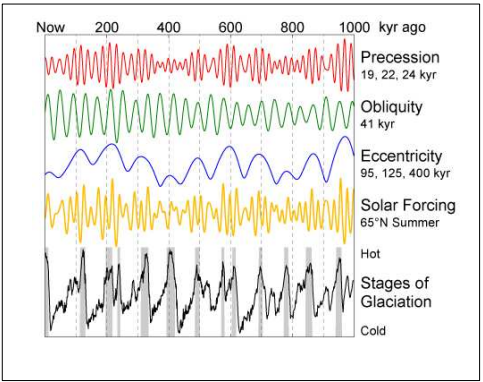
There are also other factors that affect the Earth’s climate that come from ‘outside’ the Earth (we can call these external forcings). You have probably heard of sunspots. There have been periods when there are less sunspots (the sun is cooler). When the sun is cooler, the Earth is cooler, too. These also have an impact on Earth’s climate, but on much shorter time scales (generally decades).
So, the longer answer to your question is that there are some factors that affect Earth’s climate that come from outside. These have big impacts on our climate and can ‘set up’ positive feedback loops meaning that when one thing happens it leads to another process which then causes some thing else. Like dominoes falling over. Or maybe like when you get up in the morning feeling a bit grumpy and say something not so nice to your brother or sister. They’re then nasty back to you and you get grumpier. When you go to school you’re still grumpy and take it out on your friends who then get grumpy with you. This would be positive feedback because one bad thing leads to another bad thing (or if you got up happy and said nice things…etc. That would also be positive feedback).
It is hard to know what will happen in the future with man-made climate change which is warming our planet very quickly. If we continue release CO2 as we are at present, we are unlikely to experience another ice age any time soon. Our orbit of the sun is currently quite ‘circular’ (or least elliptic) but is slowly becoming more eccentric. So, it is reasonably likely that some time in a little less than 100,000 years the Earth may enter another glacial period.
What it will look like then is another matter altogether.
The science of climate change is now settled. After decades of research on the causes and impacts of climate change, we understand what is causing the climate to change and what needs to be done about it. It is now social and political responses that are needed. And this is where politicians come in.
Politicians definitely do have power when it comes to decision making about climate change. This is the case at all levels of government: Federal, state and local. Governments can make laws and policies which could both reduce the harms being done to the climate and help us adapt to the changes that are already here. For example, in 2022, after years of not having a high enough emission reduction target the Australian Federal government legislated a 43% emissions reduction by 2030 which is a step in the right direction for getting us to ‘net zero’ emissions (no more emissions than can be absorbed or captured) by 2050. The Federal government has also set a goal for 82% of national energy to be from renewables by 2030. The problem is, just making legislation for mitigating climate change is not enough. It needs to be followed by action to help us get there. Right now, experts say Australia is not likely to meet either of these targets.
Unfortunately, governments also have power to take us in the wrong direction when it comes to tackling climate change. For example, in May 2023, the Northern Territory government approved the development of the Beetaloo Basin gas field. This huge methane gas reserve, when extracted and burned, will create enough emissions to undo much of Australia’s current emissions cuts. This is happening at a time when the International Energy Agency says there can be no new fossil fuel development if we are to reach net zero by 2050.
In democracies, elected government representatives are supposed work in ways that people want them to. We know that in Australia right now, over 80% of people are concerned about climate change and want to see climate action. There is a clear disconnect, then, between people’s climate concern and the pace and scale of government action on climate change. As citizens, we need to let politicians at all levels of government know that they aren’t acting urgently or significantly enough – and hold them accountable. How can we do this? Young people have taken out court cases against government and protested in the streets. We can join them. Also, join with an adult and write to your MP. Get involved in local climate mitigation and adaptation action. Get educated about climate change and use your vote for climate when the time comes.